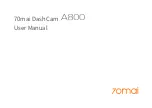
The loading key advances the film to the first exposure, after which the film counter in the side of the magazine indicates the
number of exposures made. The wide angle finder incorporates a prism to show the spirit level. The self-timer on the shutter
permits delayed releasing. The shutter speed ring acts the shutter speeds, and the aperture lever the apertures; these two are not
interconnected. The transport knob advances the film, but the shutter must be tensioned separately with the tensioning lever. The
Posh socket takes standard co-axial plugs; the MX lever selects the type of synchronization. A cable release socket is mounted next
to the release button. The signals on the camera and magazine indicate whether the picture has been exposed or the film needs
advancing.
Shooting with the Super Wide. From left to right: Wind the film transport knob; set the aperture and shutter speed separately;
tension the shutter; set the lens to the appropriate subject distance; view the subject through the finder and release the shutter.
HASSELBLAD LENSES AND FINDERS
Lenses for the Hasselblad 500C
Every interchangeable lens for the Hasselblad 500C camera has its own built-in Synchro-Compur shutter, automatic and manual
aperture adjustment, automatic depth of field indicators, exposure value scales and delayed action.
The iris diaphragm on the latest versions of the Hasselblad 500C lenses has a special release lever to stop down the lens to its
preselected aperture during viewing. This lever is on the shutter rim on the winding knob side of the camera when the lens is mounted
on the Hasselblad, and protrudes between the words "Synchro" and "Compur" engraved on the shutter. Pressing the lever down closes
the aperture; this provides a preview of the depth of field of the screen image. The latter is of course then correspondingly dimmer.
The iris then remains closed down to that value until you press the shutter release and tension the shutter again with the winding
knob. If you want to open up the lens to full aperture again before shooting, set the aperture selector ring to the maximum aperture,
and then to the required smaller aperture again. The iris now once more remains fully open until you release the shutter (or press the
preview lever).
The series of lenses consists of:
THE 40-mm. ZEISS DISTAGON is an extra wide-angle lens with an angle of view of 88 degrees consisting of ten elements, has a
focusing range from 20 in. to infinity and apertures from f 4 to f 32. The lens accepts Hasselblad filters series 104.
www.mr-alvandi.com
Summary of Contents for 1000 F
Page 18: ...WILD LIFE www mr alvandi com ...
Page 52: ...THE CUT FILM ADAPTOR www mr alvandi com ...
Page 54: ...Daylight Exposure Values www mr alvandi com ...
Page 55: ...Filters for Black and White Film www mr alvandi com ...
Page 59: ...Close Ranges with 50 60 mm Distagon and Planar 80 mm www mr alvandi com ...
Page 60: ...Close Ranges with 120mm S PLANAR 150 200 mm SONNAR www mr alvandi com ...
Page 62: ...Conversion of Film Speed Systems Colour Films www mr alvandi com ...
Page 63: ...Black and White Films www mr alvandi com ...
Page 64: ...www mr alvandi com ...
















































